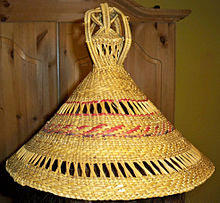Mokorotlo
Mokorotlo ( English Basotho hat , "Basotho hat") is a traditional straw hat in Lesotho . It is modeled on the Qiloane mountain near Thaba Bosiu and is considered a national symbol .
description
The hat is woven from dried grass . The grass variety moseha is used for the lower frame, the variety loli for the body and the outer layer . At the top it has several loop-like struts. From there it increases in a conical shape downwards. It has one to three horizontally arranged braided patterns, which are often also delimited by color, mostly red or green. The mokorotlo was initially made by men and later also by women. You start with the tip and end at the bottom. The Mokorotlo is mostly offered in street shops.
history
Before the arrival of the Europeans, the Basotho wore the conical straw hat khaebana as protection from the sun . In the 1910s, the thloro hat came up for the barena , which they wore when holding court hearings and on the way there. They sang traditional songs called mokorotlo in the singular . After all, hats were also called that. New designs were created in the 1930s and 1940s. This is how the loops at the top were created. The mokorotlo has been part of national clothing since the 1940s.
Origin and meaning
The sandstone mountain Qiloane near Thaba Bosiu is considered a model for the shape of the Mokorotlo. The national flag from 1966 to 1987 and the national flag in force since 2006 include a mokorotlo. A Mokorotlo is shown on each of the Lesotho license plates.
The handicraft shop Basotho Hat in the capital Maseru is built in the shape of the hat and has a thatched roof with a metal construction at the top.
Individual evidence
- ^ Scott Rosenberg, Richard W. Weisfelder, Michelle Frisbie-Fulton: Historical Dictionary of Lesotho. Scarecrow Press, Lanham, Maryland / Oxford 2004, ISBN 978-0-8108-4871-9 , p. 61.
- ^ A b c Scott Rosenberg, Richard W. Weisfelder, Michelle Frisbie-Fulton: Historical Dictionary of Lesotho. Scarecrow Press, Lanham, Maryland / Oxford 2004, ISBN 978-0-8108-4871-9 , p. 60.






